This page covers some some cooling options for camper vans. They range from passive methods through forced ventilation and evaporative cooling to full air conditioners.
A lot of people doing camper van conversions want to be independent of shore power or generators, and generally, this is very doable. But, if you need air conditioning for your camper, it becomes much more difficult. Some methods for doing air conditioning on camper vans with no shore power or generator, and only batteries and solar are discussed below.
Definitely interested in hearing other ideas on how to cool camper van — please add a comment below.
Passive Cooling
Some features that will make your camper van more comfortable on warm days:
- Choose a reflective paint color like white.
- Insulate the van well — if you can include a reflective layer with an airspace in the insulation stackup, this helps with radiant heat transfer.
- Provide windows and/or vents for air circulation
- Use reflective shades in the windows to insulate and (more important) to avoid solar heat gain.
- Park in the shade — shade makes a very large difference in what the inside temperature will climb to. Cuts heat gain about in half.
While I have not seen anyone do this, some form of shade that you could deploy over the van to effectively shade it would be quite effective. Even a shade spaced 2 or 3 inches off the van should be very helpful. Got any ideas on how to do this?
These methods, plus a fan for forced ventilation (next section) may be enough for some climates.
Update July 2018 – A practical sunshade for the van:
This is an external sunshade developed my MSNomer of the ProMaster Forum. It is made from Tyvek and attached to the van with magnets.
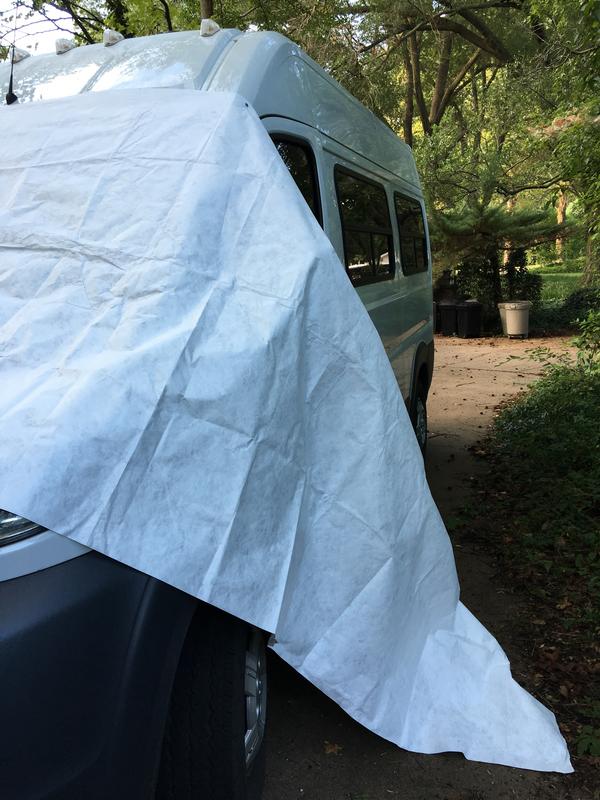
By measuring the van skin temperatures on the outer skin of the van in in the sun and in the shade, I estimate that the heat gain to the van in the sun is about twice what it is in the shade. The Tyvek sunshade is probably not quite as good as being in the shade, but it should be close. The more of the van exterior you can cover the better, and if you can space it off the van a bit, that would be very good. Post on the PM forum describing the sunshade… MSNomer’s very good website…
Forced Ventilation
Many camper vans and RVs use roof mounted powered fans to provide forced ventilation. These fans do a great job of getting the inside temperature down close to the outside temperature. Its good to combine the power fan with the passive cooling methods mentioned above to get the best effect.
The two most popular brands are the MaxxFan and the Fantastic Fan — there may be other good ones out there. Our MaxxFan has ten speeds, will blow air in or out, will automatically turn off and on to control temperature, and has a remote control — pretty fancy, and it does the job well.
One thing to bear in mind with these fans to work and actually circulate air, there have to be windows or vents for the fan to pull the air in from (or push it out to if the fan is in intake mode). Some people who do not want to have windows use floor vents for this purpose.
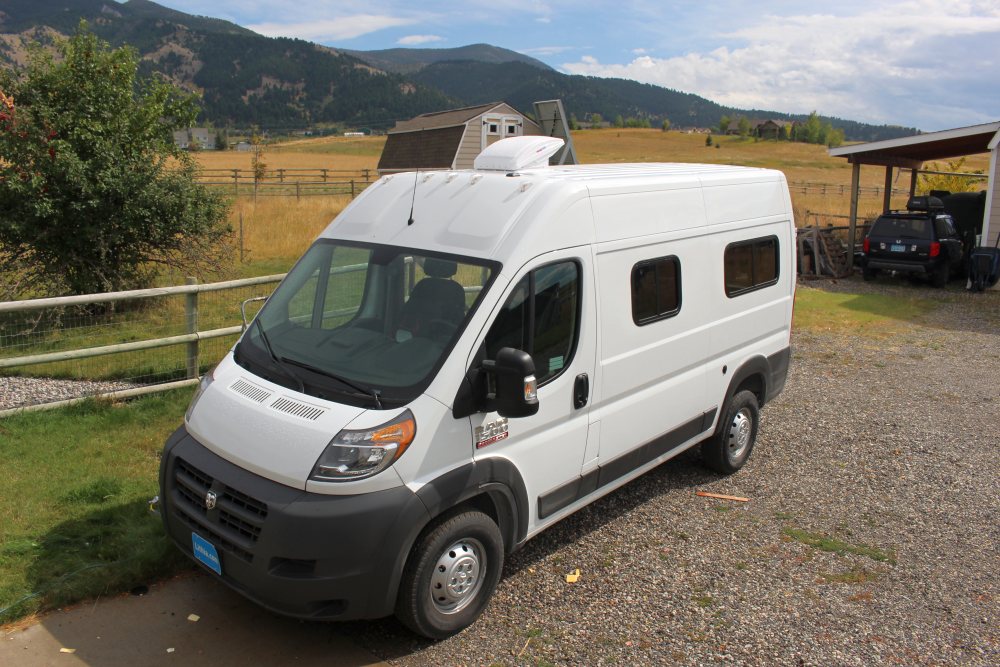
This is a test I did on cooling provided by our MaxxFan. In a nutshell, the fan was able to lower the inside temperature from 93F to 82F with an outside ambient temperature of 78F.
But, at best, the fan can only lower the temperature inside the van to what the outside temperature is, and it cannot lower humidity. So, if its really hot and humid outside, the inside of the van is not going to be comfortable. You will have to avoid these conditions, or go to one of the cooling methods listed below.
Evaporative Cooling
Evaporative cooling uses the evaporation of water to cool an air stream. Each pound of water evaporated removes nearly 1000 BTU from the air stream doing the evaporating. Evaporative coolers can be quite effective, and will reduce the temperature of a low humidity air stream by 20 or 30F. But, evaporative cooling is not effective when the humidity is high — see the chart below.
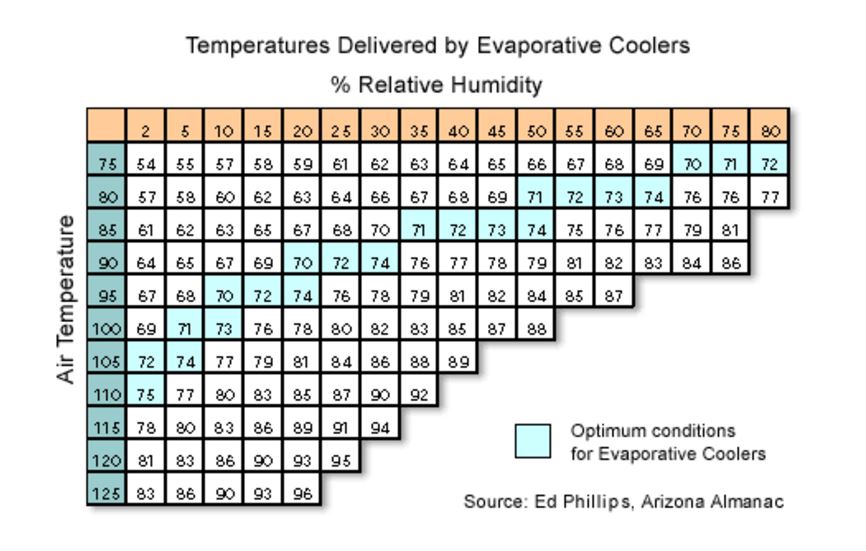
The big advantage of evaporative cooling is that it takes very little power to operate one compared to conventional compressor AC units. They can be operated on solar and batteries quite nicely and do not require either shore power or a noisy smelly generator.
Commercial Evaporative Coolers
TurboKool is a commercial unit that will cool about 750 cubic ft per minute of air by 20 to 30F depending on the ambient conditions. One of these units should effectively cool an insulated camper van. It has about the same footprint as a common RV roof AC, and installs in the same 14 inch square opening.
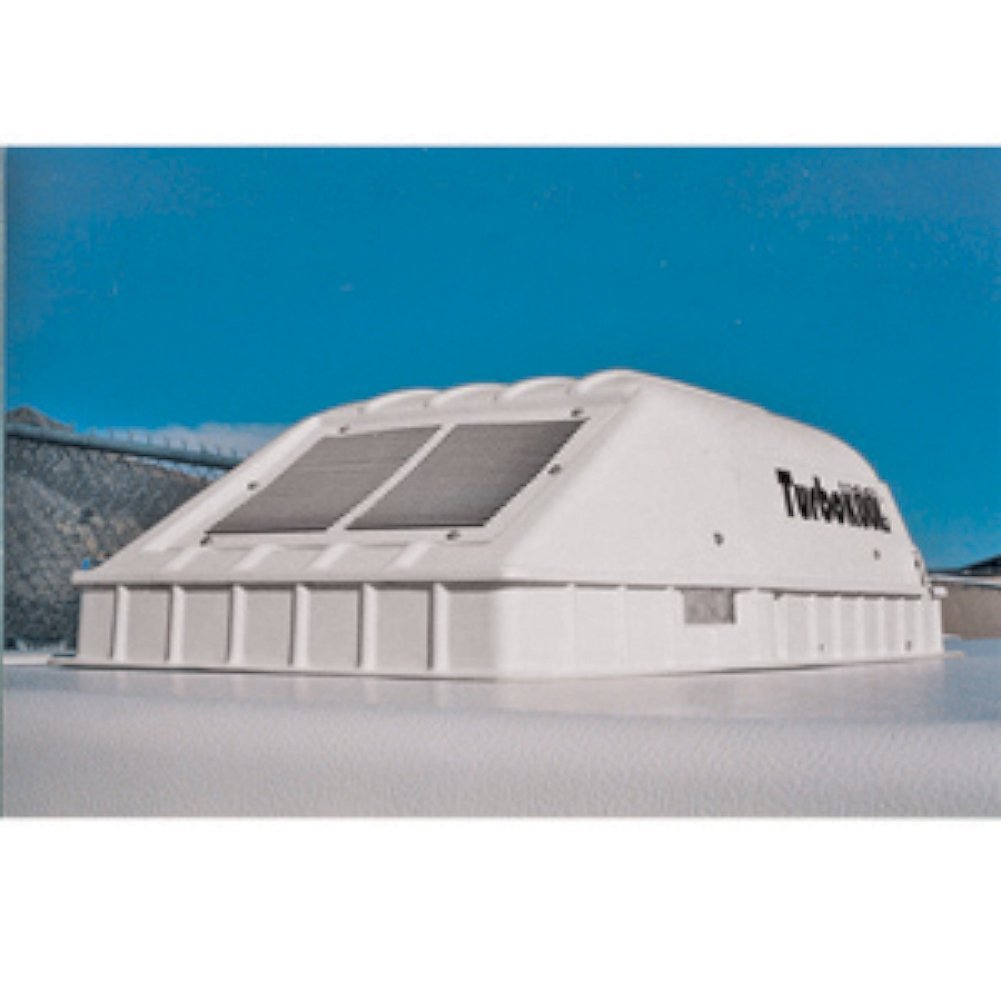
A detailed review… It also gets generally good ratings on Amazon…
Evaporative coolers use water. There is a formula for estimating how much water an evaporative cooler will use here.
It is;
Gal Per Hour = CFM * deltaT * efic / 8700
Where:
CFM is the cooler airflow in cubic ft per minute.
deltaT is the inlet temperature – outlet temperature
efic is efficiency (they recommend 93%)
If you take the TurboKool commercial unit above, it puts out 750 cfm, and if you assume a 20F temperature drop, it would use (750)*(20)(0.93)/(8700) = 1.6 gallons per hour. This is on high speed, so maybe actual average use might be lower.
So, if you used it for 12 hours in a day, it would need 19 gallons. A lot of camper vans don’t have huge fresh water tanks, so this could be a problem if there is not a source of water around the campground. The water does not have to be drinking water, so taking it right out of the river or other non-potable supplies would be OK.
The efficiency is quite impressive. Judging by the reviews, the TurboKool when operating in low humidity conditions provides about the same level of cooling as a conventional roof top RV AC unit. The TurboKool uses about 50 watts while the roof top AC is more like 1000 watts, so, the TurboKool is about 20 times more energy efficient. This makes it very practical to operate on solar and batteries. The key caveat that it needs low humidity conditions.
SouthWest Solar makes some evaporative cooling units that might be adapted for using in cooling camper vans.
DIY Evaporative Coolers
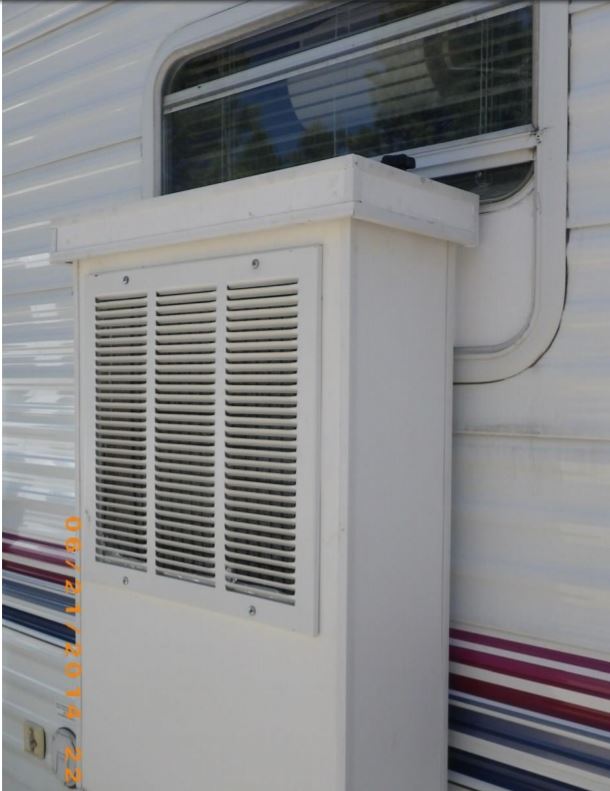
This is a DIY evaporative cooler from my Build-It-Solar site that has been used successfully to cool a trailer. The link provides quite detailed instructions on how to build the cooler.
Another very innovative and simple DIY cooler as built by RD at the ProMaster forum…
RD’s design uses his Fantastic Fan roof fan to push air through a watered pad and then blow out the holes in the outer bucket. On a 93F outside day, the air coming out at the cooler was 63F, and it was able to cool the whole van down to 85F. Total cost $20.
Yet another DIY small evap cooler…,
Air Conditioners
This section discusses “true” (compressor based) air conditioners — the ones that require a whole lot of electrical power to run, but provide good cooling even in hot and humid conditions.
Efficiency
Because these units use a lot of power, efficiency is quite important.
Air conditioning units vary quite a bit in efficiency. If you want to be able to operate your AC independent of shore power or generators, then efficiency is very important. AC units draw a lot of power and most camper van conversions won’t be capable of running a conventional AC unit for very long, but the more efficient it is, the more likely you will be able to run a while on batteries and solar. All of the methods listed above under Passive Cooling (insulation, reflective shades, light color van, and shade) make the job of the AC unit much easier and will reduce the power used and extend how long your batteries will last.
While efficiency for AC units is stated in different ways, I’ve tried to give the EER (Energy Efficiency Ratio) for each of the AC units discussed below. The EER is defined as the cooling output in BTU per hour divided by the power input in watt-hours per hour. The EER test is normally done with an outside air temp of 95F, and an inside air temperature of 80F dry bulb and 67F wet bulb.
So, for example, if an AC unit produces 8000 BTU/hr of cooling while using 800 watts, the EER would be (8000 BTU/hr) / (800 watt-hrs/hr) = 10 EER. Choosing an AC unit with a higher EER will reduce power consumption.
RV Roof Air Conditioners
RV roof air conditioners have been around for many years and are the most common way of air conditioning RVs. Some RVs use one roof AC, while larger ones use two or even three. They come in ratings from about 8000 BTU/hr to about 16,000 BTU per hours. Here are some examples.
| AC Unit | Cooling (BTU/hr) | power (watts) | EER |
| Coleman Mach 3 PS | 13,500 | 1090 | 12.4 |
| Coleman Mach 3 Plus | 13,500 | 1190 | 11.3 |
The Mach 3 PS, where PS stands for power save, is recent design aimed at efficiency, and the 12.4 EER is good for RV roof ACs.
Update: This Mabru 12,000 BTU air conditioner runs on 12 volts and is claimed to be more efficient than other rooftop AC designs. Initial reviews appear to be favorable.
Please leave a note in the Comments section if you have experience with this unit.
Splits and Outdoor
Climate Right offers some interesting outdoor and mini-split ACs that are intended for trailers, tear drops, kiosks, etc. — could work out for a camper van.
YouTube video on installing a mini-split on small trailer…
Some efficient and fairy small mini-splits shown on Thermospace.com…
This is a unique split AC. It has an inside and outside unit (like all splits), and the two are permanently connected together. To use it, you open a window in the van, and from the outside you pass the inside unit through the window and hang the outside unit on the window sill.
For travel, you take it off and store it inside the RV.
It only runs on 220 VAC. Provides 2400 BTU/hr cooling, which is kind of low. The EER is about 7 — not so great.
This interesting post on the Transit Forum shows how one person was able to convert the very efficient Midea window AC (SEER 15) into a mini-split.
12 volt split AC
These Cruise-n-Comfort air conditioners run directly from 12 volts, so don’t have to deal with the inefficiency of the inverter. On these units, the condenser is mounted outside the vehicle and the evaporator is mounted inside.
They are pricey at about $4K.
A DC Powered Mini-Split
This DC powered mini-split from Hotspot Energy looks promising. It runs on 48 volts DC, so no inverter is required to convert the battery/solar DC to AC – this results in an about 15% gain in efficiency.
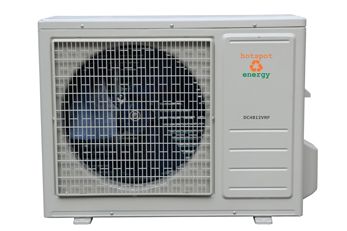
The SEER is listed as 19.2, which is quite good for an RV air conditioner. Price is about $2100 for just the Mini-Split – they also sell kits that include solar panels and batteries.
Adapting Window Air Conditioners
Small AC units made to fit in a window and provide air conditioning for a room are commonly available, compact, cheap and fairly efficient. The most efficient ones have EERs around 15. There are several schemes for adapting these units to camper vans. The Energy Star Room AC ratings allow you to compare EERs – note that the ratings give CEERs, which account for standby power use that is not included in the EER ratings. Right now, the Midea brand appears to have the best CEERs.
It takes some work to adapt these window ACs to use in a camper van, but people have worked out some ways to do it — some listed below.
One new window AC from Midea seems particularly well suited for van conversions in that it uses the same kind of more efficient design that is used in a lot of mini-splits. This not only makes the unit quieter, but also efficient enough that it might be possible to run it off batteries and solar (at least for some conditions). I would say that this is one of the best options for AC for a camper van with a chance of running on solar and batteries. It seems well suited to a backdoor mount.
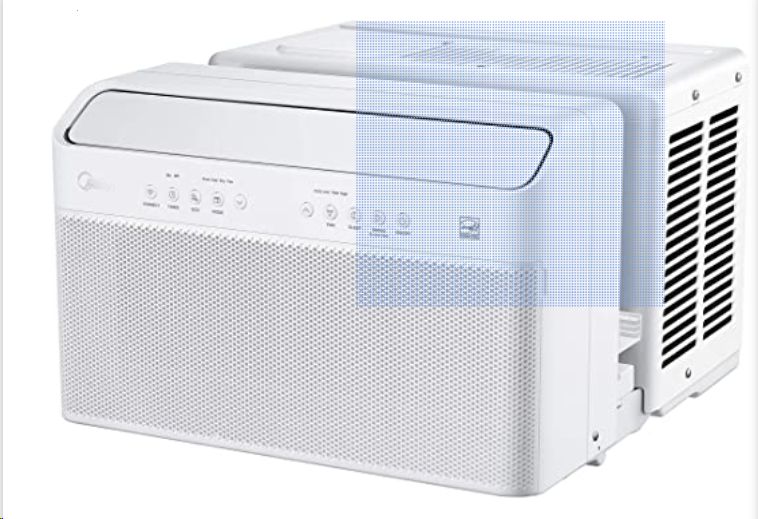
Mounting methods for window ACs range from replacing a van window with an adapter plate that the AC unit is mounted on, to mounting the unit inside the van and then arranging for a flow of outside air over the AC condenser. Examples below.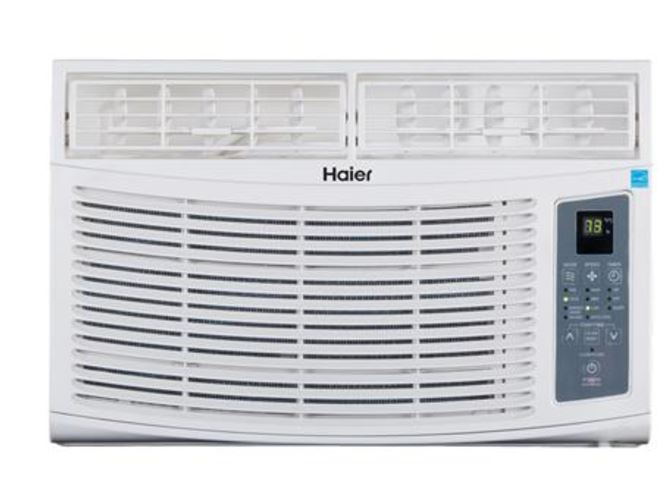
Haier Energy Star window AC, EER 12.3.
Window AC example 1:
Wbullivant on the ProMaster Forum worked out a way to install a 5K BTU window AC in the bed platform of his ProMaster van conversion. Its a very nice installation that does not take up much space. He uses two 4 inch vents that go through the floor to circulate air though the condenser coil on the AC. If he AC was installed in a window, outside air could circulate freely around the condenser coil to cool it, but since on his mounting, the condenser coil is inside the van, and the 4 inch vents are required to circulate outside air to cool the condenser.
He used a Frigidaire similar to this one with one… with an EER of 12.2.
More details on his post on the forum…, and at this photo link…
I did some testing on a window AC that we had lying around… It is pretty clear from the testing that restricting the cooling airflow to the condenser coil on the AC can have a major impact on efficiency of the unit and maybe even on its ability to operate at all. Time spent on getting good ventilation to the AC condenser is well spent. The testing at the link above provides some data that will help with sizing the venting.
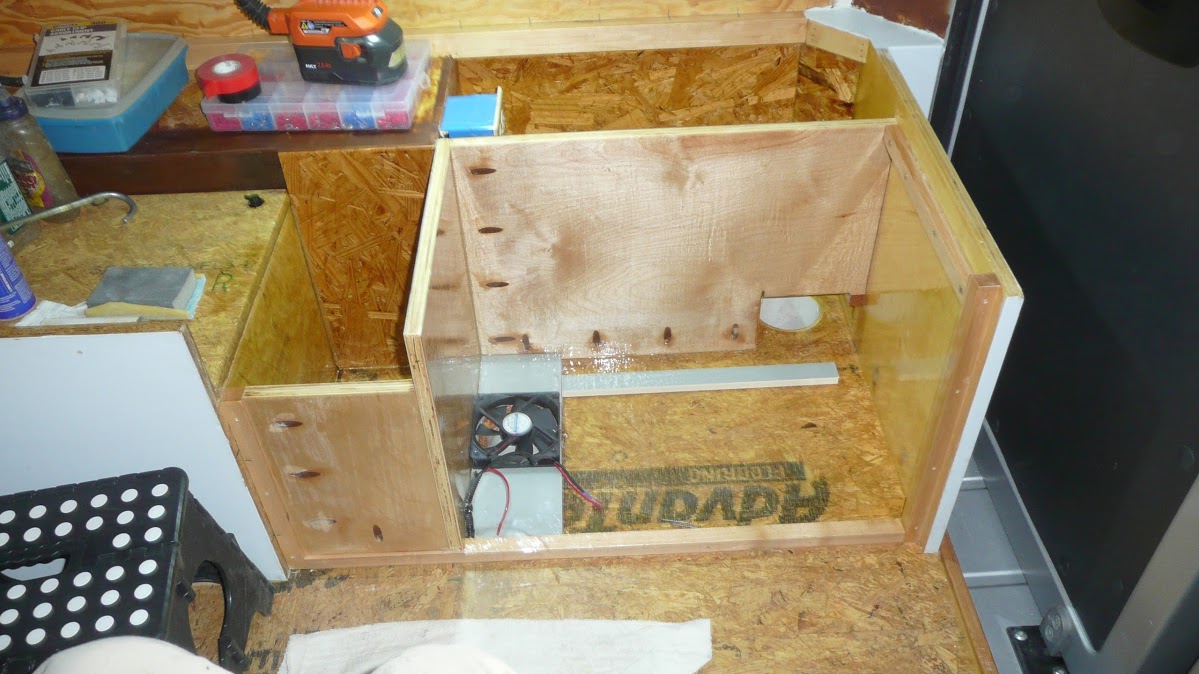
Winow AC Example 2:
Here is another use of a window AC on a van conversion. It mounts the AC unit near the bottom of one of the back doors. The result is not aesthetically bad, is strong enough to support the AC unit, and does not interfere with other uses. It also takes up essentially no interior space in the van.
Window AC example 3:
Here is yet another idea for mounting a window AC unit. The AC unit sits on a counter top while traveling, but slides outward through a hatch in the van sidewall when stopped. No rerouting of the air flow is needed as when the AC is in the slid out position, it is just like it was installed in a window. A marine hatch cover is used to close up the opening when in travel mode. The slide is a regular hardware store slide. Some garage door rubber weather stripping is used to seal the edges of the opening when the AC is in the out position.
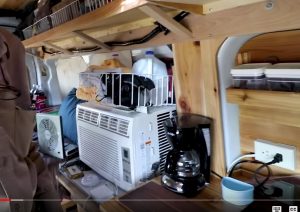
Window AC Example 4:
Pretty slick arrangement.
The full video for this van conversion is here…
Thanks to Mark and Lissa for finding this scheme — see comment section below.
Here is another nice install of a window AC.
The window AC pulls in and out on drawer slides.
Full description in the ProMaster Forum post…
Portable ACs
With a portable AC unit, the entire unit is inside the room being cooled and hoses are used to pull in ambient air and to exhaust the hot air that comes from cooling the condenser coil. The appealing thing for a camper van is that the unit is easily removed from the van when its not needed, but on the negative side, they take up space, are noisy, and are not as efficient.
Portable AC units are not as efficient as window AC units and are noisy– this is a quote from Consumer Reports in 2008:
While portable A/Cs might be convenient, those we tested delivered only about half of their cooling capacity—that means they operated with an energy-efficiency ratio (EER) of about 5 or 6. Compare that with the minimum EER of just under 10 for the window air conditioners we’ve recently test (we tested window models with an EER as high as 12).
More from Consumer Reports on portable ACs…
If you are trying to operate from batteries/solar, the lower efficiency will cut operating time significantly.
Operating on Solar and Batteries
The section provides a little data on what it takes to air condition a camper van using solar and batteries.
Efficiency and Energy Use
The table below compares an example or two of each of the above AC units on how much cooling it provides and how energy efficient they are.
EER is an efficiency rating — the higher the better.
| Model | Type | Cooling | Power | EER | Flow | Battery Drain |
| (BTU/hr) | (watts) | (CFM) | (amp-hrs/hr) | |||
| Coleman Mach 3 PS | Roof | 13,500 | 1190 | 11.3 | 325 | 104 |
| Coleman Mach 3 Plus | Roof | 13,500 | 1595 | 8.5 | 325 | 140 |
| Climate Right | Outdoor | 5,000 | 700 | 7.1 | 130 | 61 |
| Climate Right ductless minisplit | mini-split | 12,000 | 1241 | 9.7 | 323 | 109 |
| Thermocore, T322S-H109 | mini-split | 9,000 | 960 | 9.4 | 306 | 84 |
| Fridgadaire FFRE0533S1 5000BTU | Window | 5,000 | 410 | 12.2 | 124 | 36 |
| Haier Window 5400 Btu | Window | 5,400 | 440 | 12.3 | 180 | 39 |
| TurboKool (evaporative) | Roof | 10,000(?) | 60 | 167(?) | 750 | 5 |
Where:
Cooling output on high in BTU per hour.
Power consumption in watts at high cool.
EER Energy Efficiency Ratio — ratio of cooling output in BTU to electrical power to run in watts. Higher is better.
Flow is airflow from outlet vent in high speed in cubic ft per minute.
Battery Drain is the number of amp-hrs that would be drained from a 12 volt battery with the AC run continuously on high.
How much cooling is needed?
This depends on a lot of things — like:
- How hot and humid is it outside
- How big is your van
- How well insulated is your van
- Are windows insulated and have reflective shades
- Can you park in shade vs direct sun
Some have reported descent cooling of insulated camper vans with 5000 BTU/hr AC units, while some have reported only getting satisfactory cooling with larger (say 13,000 BTU/hr) units.
My van is a 136 wheel base (18 ft overall length) high roof ProMaster. It is insulated with 1 inch of polyurethane foam insulation (floor, ceiling, and walls),, and the windows are insulated with Reflectex plugs that reflect and insulate. The calculated heat gain with an outside temperature of 95F and inside temperature of 75F is only about 1600 BTU/hr. To this we need to add the heat gains inside the van — each human adds about 500 BTU/hr and pets also add heat, things like refrigerators, inverters, lights .. also add some heat to the interior. So, allowing 1500 BTU/hr for these gains, the total heat that the AC must remove on a 95F day might be about 3000 BTU/hr. This analysis assumes that your are parked in the shade — that is, no direct gain from the sun. In addition, while a capacity of 3000 BTU/hr might be enough to meet the steady state demand, more capacity will be needed to initially cool the van down. So, while this seems to support the idea that a 5000 BTU/hr AC unit might do the job most of the time for a well insulated van, it might come up short some of the time.
Note that the heat loss from a non-insulated version of my van under the same conditions is 7500 BTU/hr — 4.5 times as much as the insulated version.
Another thing to keep in mind is that solar gain from windows or windshield in direct sun can be very large. Ten sqft of window area with 80% transmittance in direct sun will gain about 2200 BTU/hr — more than doubling the heat gain of the basic van. So, be sure to use reflective window shades.
Operating on Batteries and Solar
If you want to have any hope of operating your conventional air conditioning on batteries and solar, you will have to
- Insulate the van well
- Use an efficient AC unit
- Have a large battery pack and solar array
If we assume 95F outside and 75F inside and the well insulated van described above with the internal gains used above, and parked in the shade. Then the steady state cooling need is about 3000 BTU/hr. If we assume an efficient 5K BTU/hr AC unit with an EER of 12, and we assume an inverter efficiency of 95%, then the steady state power usage is:
Power to AC = (3000 BTU/hr) / (12 EER) = 250 watts, or 250 / 0.95 = 263 watts from the battery — this is about 22 amps on average from the 12 volt battery. This basically assuming that the 5K BTU AC unit runs 60% of the time. So, under this fairly optimistic scenario, 22 amp-hrs are removed from the battery each hour. If you had a 440 amp-hr battery pack (eg 4 golf cart batteries), and discharge it to 20%, and assume 4 amp-hrs of other uses (eg fridge, lights, …), then you could get (440 amp-hrs)*(0.8) / (22 amps + 4 amps) = 13.5 hours of van operation with AC out of a fully charged battery. Not too unreasonable.
Its practical to install about 600 watts of solar on a camper van roof — maybe more with the longer vans. PVWatts says that on average in (say) Truth or Consequences, NM in mid summer, with horizontal PV panels, you should average about 110 KWH per month, or 3.67 KWH per day, or the equivalent of 305 amp-hrs per day, which is a bit short of the 350 amp-hrs required to charge from 20% up to full charge. Maybe 700 watts of PV in a good solar location would do it.
Note that there is a bit of a disconnect in the above in that it assumes the PV panels are in the sun and the van is in the shade.
Its clear that its a tough challenge to run AC on batteries and solar, but with a lot of care it might be done — especially if you don’t camp in really extreme hot weather. Of course, some engine running to supplement battery charging could be used.
This is one area where the high capacity of lithium batteries would be a big plus.
Another option to get more charging would be to install a 2nd alternator designed to produce high charge rates for the house battery.
It also points out that if evaporative cooling can work in the climate you use the van it, its a HUGE advantage in getting to an AC system that will operate from a battery pack and solar.
Comments, Suggestions, Ideas?

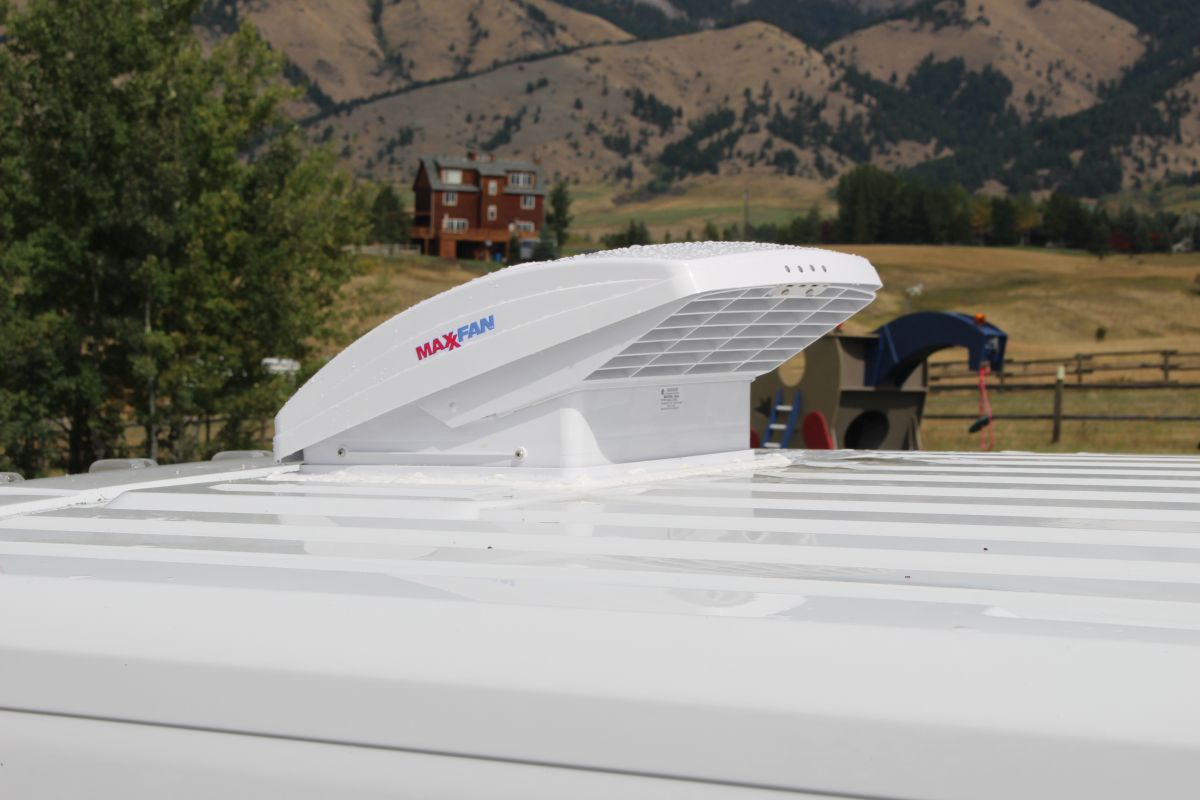
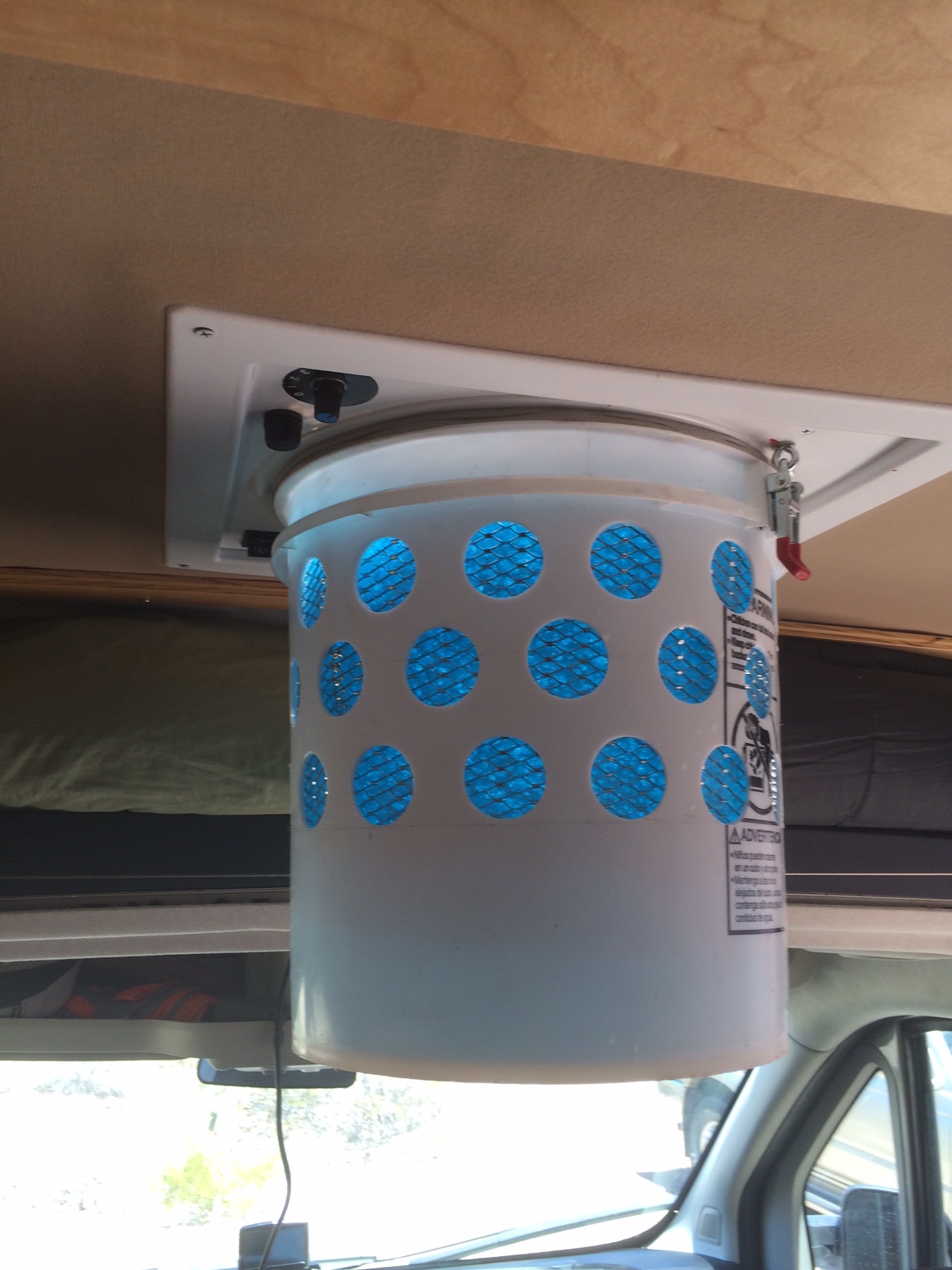
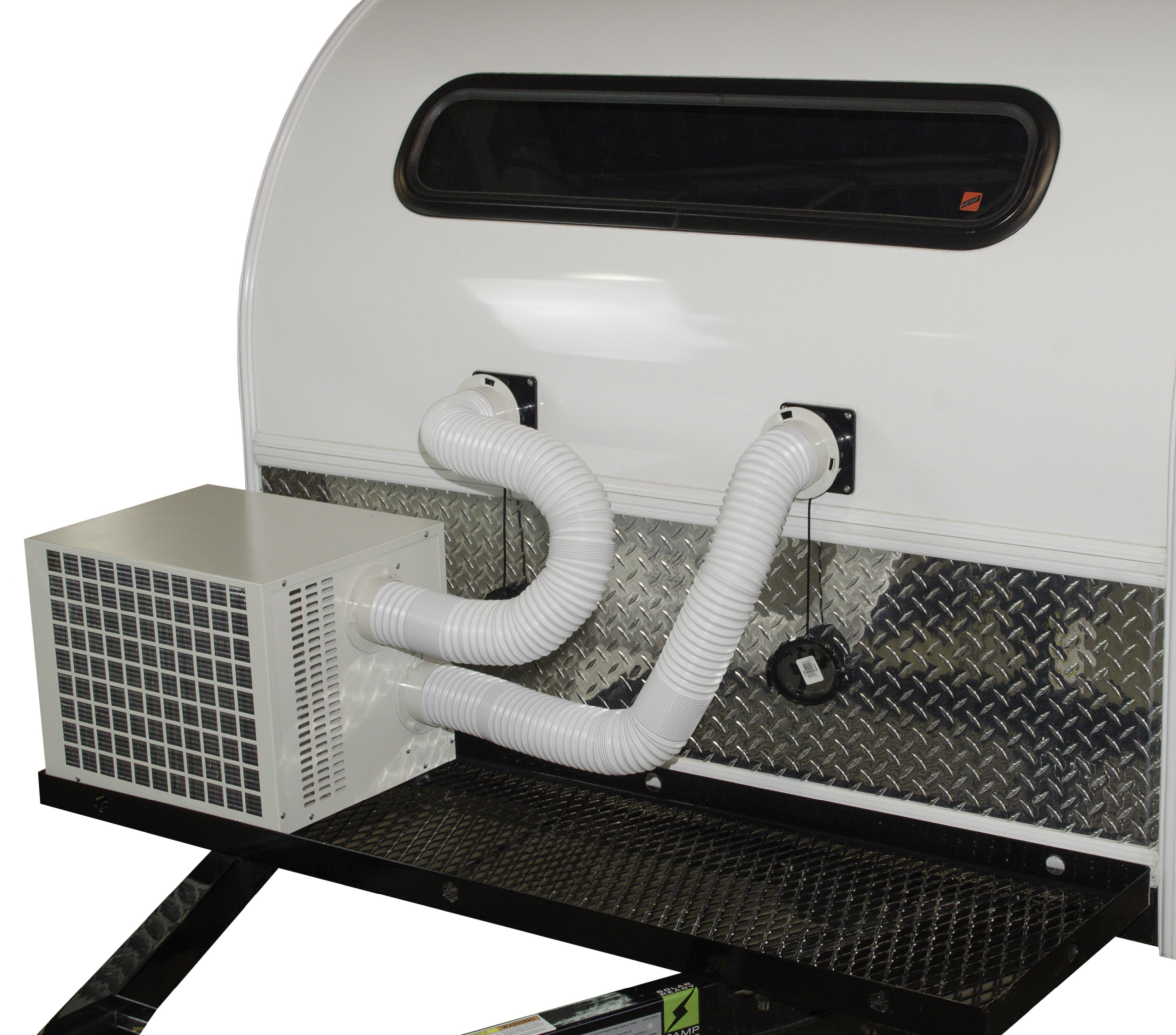
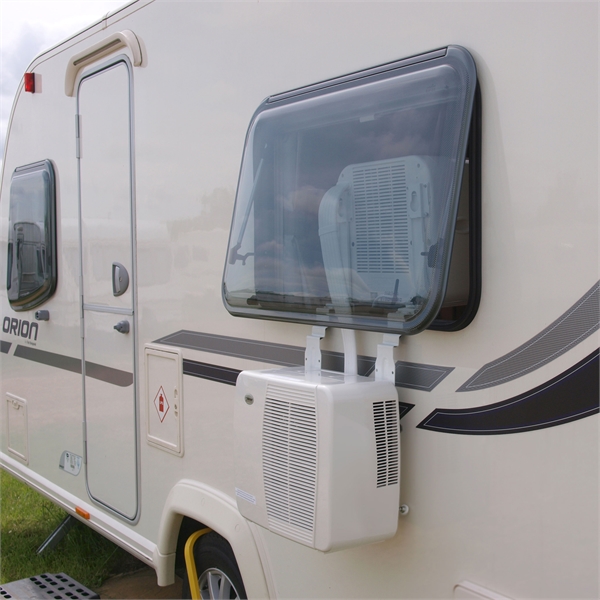

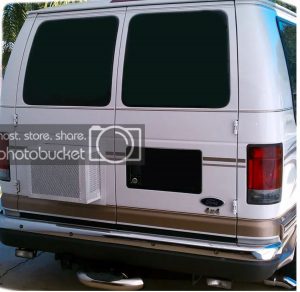
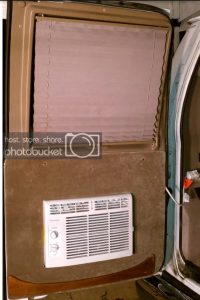
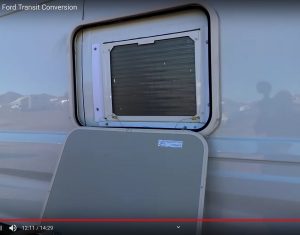
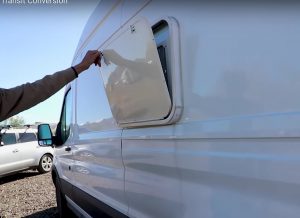
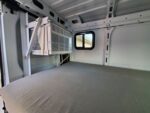
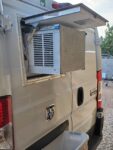

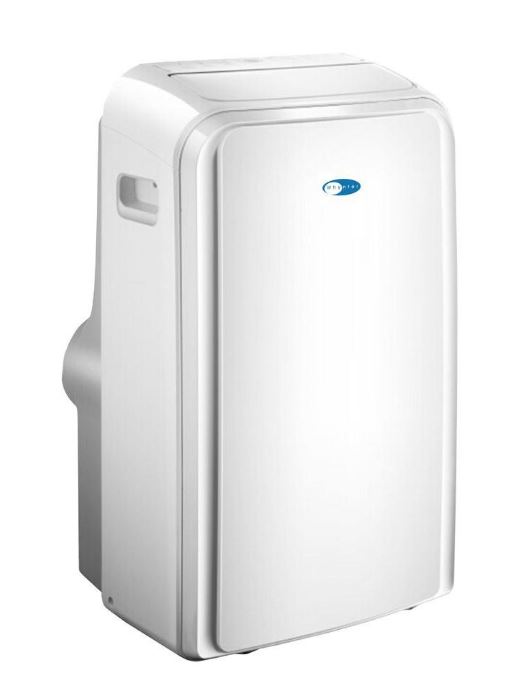
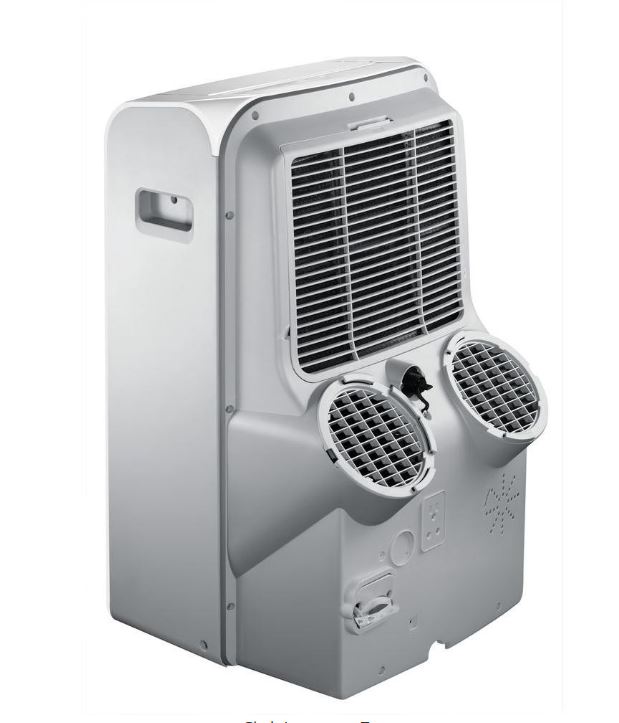
What are your thoughts about these 12v AC/ Heat units? https://www.rigidhvac.com/micro-dc-aircon-cool-heat
Hi,
Its a pretty small unit. The output in heating mode is 1023 BTU/hr. The small end of propane, gasoline or diesel heaters for vans is about 6000 BTU/hr, and they go up as high as 15,000 BTU/hr.
So, it might help to take the chill off on a not so cool morning, but its not going to heat the van in cold weather.
It is a heat pump, so its going to be 3 to 4 times more efficient in energy use than using an ordinary electric space heater.
And, of course, it does cooling also, but again with not a lot of capacity – its cooling capacity is about 1/4 of what people think is the minimum needed to cool a van in hot weather.
Gary
An interesting Marine Air conditioner (heat pump) YouTube for reference:
https://www.youtube.com/watch?v=fboQsNBJ9Lo
It’s using additional radiator to cool down circulate water.
I am wondering if exist any other fluid can be used in such design for install in my Class B.
Hi,
Interesting idea.
They are circulating a glycol water mix between the AC and the outside radiator. I guess that would work for an RV.
The basic AC unit is nice and compact, but does not appear to be too efficient – maybe roughly an EER of 8. The extra amperage to run the fans on the outside radiator would make it even less efficient. May not be such a good solution for running on battery?
Gary
Frigidaire FFRE0533S1 5000 BTU window unit has since been discontinued. However, Model: FFRE053WAE has the exact same specs and is still available.
https://na2.electroluxmedia.com/Original/Electrolux/Electrolux%20Assets/Document/Product%20Specifications%20Sheet/English/FFRE053WA_0320_EN.pdf
Thanks Roger
Looks like the EER is even a little better.
Gary
This could make it easier. 6″ tall AC
https://www.doityourselfrv.com/window-ac-unit/
Thanks John,
Nice compact unit.
The EER of 10.5 is not to spectacular, but I guess OK if you are going to run off shore power or generator.
Gary
These kids ran a 5000 btu window unit in their Lance Camper (mounted in the cabover window! f-ing genius) off a Kodiak solar generator with 400 watts a solar on the roof in Southern California. It can be done. He had some issues with the kodiak, I’d think daisy chaining another Lithium ion to it would have prevented some of his issues. Note: These kids had to relocate to North Carolina during the pandemic. Their service industry jobs in LA disappeared, I think they are originally from El Salvador. You know, the Central American country in the 80s with the mind-blowingly horrific civil war? FMLN? November 89 Offensive? Death Squads? 55 US Special Forces Advisers (there were a lot more, they just rotated them in and out of country every 90 days so they weren’t counted)? : )
https://www.youtube.com/watch?v=D33jwUzh-08
https://www.youtube.com/watch?v=QnH9ugxYLmM
What do you think about the ZeroBreeze for a Ford transit extended high roof conversion? Perhaps with the bed area curtained off, It might work. Or even two units. Bad idea?
Hi,
The specs for it say it has a cooling capacity of somewhere around 1000 BTU/hr (they seem to be a bit vague about this spec).
That’s pretty small.
An RV roof AC is normally about 13000 BTU/hr. Some van conversions have managed to get good performance out of a regular window AC unit rated at 5000 to 6000 BTU/hr, but this requires a well insulated van with thermal shades on the windows and works better if the sleeping area can be closed off to limit the area being cooled.
I guess I would be skeptical that you would be happy with the cooling from even two of these units, but I don’t have any direct experience with them, so not certain.
In a van cooling situation, you would have to use their two hose setup to vent the hot air from the condenser to the outside of the van — it might be challenging to find a good place to run these hoses to.
Some cooling options on this page: https://www.buildagreenrv.com/design-and-build-information-for-camper-vans/cooling-and-air-conditioning-for-a-camper-van/
If you decide to give it a try, please let us know how it works out.
Gary
In messaging them, the Zero Breeze MKII has a 2300 BTU rating. Thank you for your input! I’ll let you know if I do end up going with it.
Great article with a lot of information!
The Zero Breeze offered zero cooling. I ran it in my van for 1 hour and it did not lower the temp even 1 degree. I then put in in the van cooled to 74 degrees but he car ac and then turned on the Zero Breeze. After 30 min the temp started to get hotter. Overpriced waste of money. Customer service does not care.
Hi Mary,
Thanks for the report.
When you used it in the van, were you able to direct the exhaust outside the van?
Gary
Mary, that sounds about right.
The 16.5 lb Zero Breeze MKII has a 2300 BTU rating… Specs indicate 650 watts (2,218 Btu/Hr) Cooling output with 240 watt power input. That’s a COP of only 2.7 and 9.24 ER. That’s worse than most 5,000 Btu/Hr window air conditioners that put out more than twice as much cooling and weigh about twice as much, e.g., this 11.1EER unit that’s $159 at: http://www.homedepot.com/p/GE-5-000-BTU-115-Volt-Window-Air-Conditioner-for-150-sq-ft-Rooms-in-White-AHTC05AA/315262616 Even with ~5% loss from a properly sized inverter, this basic A-C unit is way more efficient than the ZERO BREEZE. Despite their hoopla about the newly improved “Mark 2”: version, there is practically ZERO REASON to use the (ironically named) ZERO BREEZE.
Hi Gary,
I recently came across “through-the-wall” ACs and thought this would be optimal for campers (I am a Promaster dual sliders myself). The difference to a window AC is that there are no intake vents in the side of the unit, the exhaust and intake are both in the rear.
So far I have only found one person using this kind of AC in a van, check out this gentleman’s video, AC is shown at 4:35min. https://www.youtube.com/watch?v=Ev2FHakHKUM&t=6s
The only downside is that these units are a few of hundred $ more than window ACs, but I think might be a worth while expense. This is an example of the AC, but there are others. https://www.geappliances.com/appliance/GE-115-Volt-Built-In-Cool-Only-Room-Air-Conditioner-AJCQ06LCG
Thanks Martina,
Had not seen the through wall units before and they do seem like a good alternative to the window ACs for some things.
Gary
It is interesting that window AC units are more efficient and quieter than portable AC units. My wife and I are preparing to purchase a van, which we plan to convert. In addition to an AC unit, I imagine we will also need a heater or heat pump of some sort to make sure we can control the temperature as much as possible.
Hi James,
You might look into a mini-split heat pump. This will give you both AC and heat, and is more efficient than a window AC or portable AC.
Here is an interesting thread on the PM forum about one person who has done this: https://www.promasterforum.com/threads/minisplit-on-rv-actual-experience.89514/#post-689977
Gary
I can’t seem to find the video, but I recall a van dweller doing a typical 5K window AC modification where when the van was in driving mode the AC was sitting on top of a beefed up table on drawer slides in the van . then when the guy parked and had AC power and wanted to use the window unit he opened a marine hatch in the side of his cargo van (that dropped down?) and simply slides the body of the unit out the marine hatch, clearing up the space on the table . I’m not sure how that was sealed from bugs and stuff ( I think the front part of the AC unit (where the accordians would normally go) had some form of weather sealing that mated close enough with the cut out to the marine hatch and the whole shebang just pushed to the edge of the marine hatch and sealed against that (exposing the body of the AC to the world, I guess you’ll have to figure out a slight tilt to the slides). As to the Kapsul brand , they keep delaying production, currently beta units are supposed to be shipping to initial kickstarters in warmer climates in September? Just to see if the first batch even work properly. It’s a long time coming for that little guy, even changed their name a couple of times along the way.
The Kapsul (formerly “Noria”) air conditioner is shorter and wider but no lighter (40-lbs.) than ordinary window units, and at 11 EER, it’s not the most efficient window A-C in this size range either, all for only what? $500? And, trying to compete in a very well-established market where the main vendors are giant conglomerates? Ain’t gonna happen.
This article is from April 2017…
https://www.phillymag.com/news/2017/04/18/noria-air-conditioner-kickstarter-kurt-swanson/
Hi Mark,
I like the idea of the slide out AC — no need to reroute airflows and no loss of usable space inside the van.
Gary
Hi, Mark,
Look at the cheaprvliving channel. I think the video you are looking for is called Stunning Ford Transit Conversion. Dated March 10, 2018. Hope this is the one you want.
Thanks Mark and Lissa for finding the slide out window AC.
I added some pictures of it and a link to the video above.
Gaey
Thanks for finding it, it looks like the most efficient type are mini splits if you can mount the head unit in the van and IF you can mount the compressor part on the rear of the van someplace (a hitch carrier etc) . I’m guessing you’d have to isolate the compressor from vibration but there are videos on Gone Boondocking youtube channel of how well and efficient mini splits are for RV’s and I guess vans.
Yes — I think that’s all right.
Here is an interesting thread on the PM forum about one person who has done this: https://www.promasterforum.com/threads/minisplit-on-rv-actual-experience.89514/#post-689977
Gary
There are a few DC-power air conditioners, e.g.:
https://www.hotspotenergy.com/DC-air-conditioner/
http://www.kingtecusa.com/pages/ac-rooftopbattery.html
http://www.kingtecusa.com/pages/ac-splittypebattery.html
And of course, they sell for a premium.
I’m not sure if Kingtec is really marketing into the North American market, because I haven’t noticed any mainstream online site that sells these.
I like how you said that efficiency is very important if you want your AC to run on a generator. My husband and I are looking at getting an RV with AC some time. Knowing how a particle AC runs will be good to take into consideration.
I did try out the misting system and things got a little too wet!
Have any of you looked an units from this company that run directly off 12v AC? Any idea how they compare in terms of efficiency?
https://www.cruisencomfortusa.com/
Hi Tyler,
They don’t appear to provide enough data to estimate efficiency.
You might contact them and see if they can provide and EER for the units.
Gary
Hi,
This guy has a 12 volt AC in his van and goes over some of the advantages.
https://www.youtube.com/watch?v=DM7eCmXXnPg
Its about half way through the rather interesting video.
Gary
Thank you, Gary, for your response and the numbers. How brutal the physics laws are!
I was searching the Internet with a hope to identify a low power split AC. An interesting, promising product came across: here is the web site https://www.kapsulair.com. It is a US company. The product is titled ‘The Kapsul W5’ is a window AC — a 5000BTU, 480W, 120V, EER 11, with the H7″ X W20″ X D22″ dimensions. It comes with the window frame adapter. The unit will extend 14″ past the window frame adapter on the outside. The AC is twice as quiet as existing units, the manufacturer claims.
It appears that no one has reviewed the product, probably because it will only be released in May of this year.
This air conditioner caught my attention because it only requires a 7” x 20” cutout. I am thinking that one suitable place to install it is in the van’s back door, right above the garage and the bed. The air conditioner will extend about 14” past the door to provide condenser’s cooling. The 14” protrusion, in my opinion, will not present issues or hazards.
It will be relatively cheap, $600 including shipping.
Gary, what is your take on this air conditioning option?
Hi Brian,
Really an interesting product — I saw it back when it was a Kick Starter project. Looks like it is really going to make it to production.
It seems like it could be a good fit for the RV back door. I have seen people put window ACs in the back door of vans, and they do work and provide the cooling. Not the most aesthetically pleasing, but this unit would look much better with its compact size.
I believe that this size AC can provide enough cooling for a well insulated van with provisions to prevent excessive heat gain through the windows.
The efficiency of the unit is up with the best of the current window ACs (EER 11) — you have to wonder how they achieve this with the more compact envelope. It would be good to see some actual test data to verify the cooling output and efficiency.
If you plan to be able to operate off the house batteries, its going to take a large battery pack.
If it draws 480 watts and is on (say) 2/3rds of the time, then its 320 watt-hrs per hour, or about 27 amp-hrs per hour — more like 30 amp-hrs per hour when you take into account the inverter efficiency. So, 10 hours would require 300 amp-hrs, and if you use conventional lead acid batteries and drain down 20% SOC, that would be about 400 amp-hrs of battery pack, and this does not include other loads in the van. It might be a good place to use Li batteries if you can stand the cost.
Gary
Hi Gary,
I would like to express my gratitude for being able to use your web site as it is certainly very informative. I would like to note the participants’ contribution, as it is comprehensive and competent. Thank you all!
May I offer my takeaway on the Air Conditioning subject?
There is an overlooked air conditioner type: Marine Air Conditioner.
But before I will go on, let’s review what marine air conditioner is. In short, it is that transfers the heat from the refrigerant gas to the seawater (as opposed to the air).
The grounds for my proposal, a possible utilization of this type, are because the converted vans and RVs have large water tanks with water to be used as the medium for the heat exchange. It may be also more efficient as opposed to the air.
Using the water tank water will increase the water temperature as a result. I believe that boosting the fresh water supply, as a sub product, is beneficial because heating water is needed anyway while this water heating stage does not require additional energy expenditures. Other air conditioner systems do not utilize that lost energy, as far as I know.
There are at least 2 potential challenges.
The drawback may be a potential water contamination for a water drinking purposes. That is because because of the condenser’s materials and the solder. To mitigate this potential issue would be to use an alternate water tank for the food consumption.
1.
I did not run any calculation regarding the marine air conditioner efficiency degradation, as the water temperature will gradually rise. At this point I am not sure if the initial benefits of warming the water would outweigh the inevitable efficiency degradation. I guess the question is how long time it would take to reach that point. The good strategy is certainly to park the van by a lake or a stream… 😉
Thank you,
Brian
Hi Brian,
Thanks, and I’ll definitely join you in thanking the people who take the time to send comments and thoughts.
Nice idea on using water as the heat sink for AC. I think it would work for fairly short time periods. If you say you can cool a well insulated van with 3000 BTU/hr and you had 20 gallons of fresh water tank, the tank temperature would go up about 18F per hour. So, if the water started at 50F, it would be up to 120F in 4 hours.
If you could work out a way to supply more cool water as you run the AC, it would not take much flow to make this very viable.
Gary
Three thoughts. First, I suspect restriction to the intake is more important. Thus, 4 inlets ducts and 2 outlet ducts probably works better than the reverse. Second, cutting the louvers out of the inlet portions of the metal shell/housing will improve the air flow, they are not needed. Third, another guy used horizontal boat vents for the outlets on the side of his van. Thanks for the excellent experiments, I appreciate it.
Now 13 months after my post above, I have since bought the van (Transit Ext high roof) and am about 60-70% into the buildout. I’m installing a solar controller and intend to use a portable panel, if at all. I’ve opted not to put one on the roof due to the drag and the fact that I’d prefer to park in the shade if possible. I’m also very interested in passive cooling and am going to try a method of deploying a tarp a few inches above the roof when camping. The idea is to install a couple of elevated rails on top to provide the standoff distance. The tarp would secure on the drivers side, drape completely over the top and then act as an awning on the slider side. We’ll see how well this works.
Hi Sally,
Congratuations on the build.
Please let know how the tarp works out — I think it will be quite helpful.
I do think you will also need some kind of fan to move air through the van to take full advantage of the shade effect from the tarp.
Gary
Thanks, Gary. Your site has been very helpful, so thanks on that, too. Our design feature essentially a quasi-separate berth area in the rear (platform bed). There’s a MaxxFan right over our heads at the far rear, and on each a EuroWindow (double pane acrylic ordered from Tern Overland) to pull fresh air in for cooling in the berth. This arrangement works very well, and it was borne out of a lesson learned from living 3 years on a sailboat.
I’m still pondering AC options, but I don’t really like any of them so far. So I’m trying to stretch out the other factors as far as possible.
Sally
Gary, thanks for your work first off . Iam looking at the Frigidaire 5000btu you recommend . We’re using a kodiak generator . The people at Kodiak Need to know the max peek start up charge in order to know how many more batteries we need to get in order to run the air for an extended amount of time . Hope this makes sense . Thank you for your time . Robert .
hi Robert,
I could not find anything specific in the specs on startup surge…
https://www.cnet.com/products/frigidaire-ffre0533s1-air-conditioner/specs/
They say 410 watts running power.
Since the Kodiak says it has a 3000 watt surge capability, I’d think it could handle the startup surge OK.
On run time, if you say the AC runs half the time, then it will use 205 watt-hours per hour of use, so the 1100 watt-hour capacity of the Kodiak should run it for about 5.3 hours, but I’d say more like 4+ hours when you consider inverter inefficiency and other power uses.
Good insulation and reflective window plugs should help with minimizing run time.
Please let us know how this works out.
Have you worked out how you plan to mount the AC?
Gary
Another small AC with high EER:
http://products.geappliances.com/appliance/gea-specs/AEM05LV
Gary
Gary , Robert here . Kodiak Will not handle surge of 5000btu air-conditioner .It ran a fan, table lamp , tv for five hours . 12 volt refrigerator For 40hrs.
My question is if I add an AGM battery will that make a difference in it being able to handle the surge ? Thanks for the advice . Robert !
Hi Robert,
Surprised to hear that it won’t handle the starting surge, given that they say it will handle a 3000 watt surge.
Seems like it would be worth having another conversation with Kodiak and see if they can offer anything.
I’m not sure that trying to parallel an AGM battery with the Kodiak’s Li battery would be a good idea. Generally batteries in parallel should be of same type an age to work well together.
Can Kodiak sell you a 2nd Li battery to parallel with the one that came with it?
Also, might be worth googling to see if there are any gadgets you can add onto the AC to reduce starting surge?
Gary
The Kodiak user manual provides surprising information on this. In summary, DON’T put an Li battery in parallel, but a standard deep cycle AGM is fine, and it is designed to handle it:
“EXTERNAL BATTERY GUIDELINES
The Kodiak was designed with end user customization in mind, in an
effort to expand the number of applications and versatility of the system.
External batteries are one of the main ways we have done this. Below are
some guidelines for expanding the power of the Kodiak through the use
of additional batteries.
Number of batteries
“How many batteries can I connect to the Kodiak?” The answer is simple,
with a small qualifier: there is no limit to the number of batteries you
could connect to the Kodiak, however regardless of the additional
cells, the charging potential of the Kodiak remains steady at 600 Watts/
hour. Simply stated, you could connect 100 additional batteries, but
the limitation would come from the charging time, making extended
configurations impractical for most.
Types of batteries
Recommended battery – Inergy recommends 12 Volt deep cycle batteries
be used to expand the Kodiak base system. DO NOT connect external
lithium batteries not supplied by Inergy. Irreparable damage or fire could
result.
Connecting
Batteries should be connected in a parallel configuration to expand
the battery capacity of the Kodiak. Any additional batteries should be
connected in the following manner: positive to positive, and negative to
negative.
Here’s the link to the user manual:
https://cdn.shopify.com/s/files/1/1654/8245/files/Kodiak_Manual_2018.pdf?4931325425958293556
Thanks very much Kevin!
Gary
I just tested my Kodiak with a Haier 5kbtu AC Model #: HWF05XCR.
It cranked up and cooled just fine. I don’t know what the surge amperage is.
Hello and thanks for this great resource! Would it be possible to place a TurboKool side-by-side the MaxxFan on the roof of the PM? I’m trying to maximize the roof area for solar panels.
Hi David,
The TurboKool only weighs 16 lbs and fits in the same size 14 by 14 hole as a maxxfan, so maybe it would work. I think you would want to add a roof rib forward and another aft of the two fans — these could probably be 2 by lumber.
But, I wonder if the TurboKool has a fan only mode so that it could replace a Maxxfan? That is, use it to circulate air without the evaporative function?
Gary
Yes, you’re right the TurboKool does have a fan-only mode. That makes things much simpler. Also great that they share the same 14×14 opening in case I’m not happy with the TurboCool and want to change to the MaxxFan/compressor AC combo.
Sounds good.
Please let us know how you like the TurboKool — sounds like a very promising AC for dry climates.
Gary
I just bought a new house and the home owners association requires that my Hymer Aktiv Dodge Promaster RV be parked in the garage. But the air-conditioner is 6″ too tall to fit in the garage so I want to know if I can remove the air conditioner unit. I don’t need it anyway since I live in a colder climate.
HELP!
Victoria
Hi Victoria,
I think you can.
You will need to plug the hole in the roof left by the AC unit. I think its 14 by 14 inches, and I’d be surprised if there are not people out there who make lugs to fit removed AC unit holes.
The AC units are heavy, so some help with getting it down from the roof would be a good thing.
It would probably be worth asking your question on the PM forum.
You could also consider putting a roof fan in that fits the same size hole, but that has a low enough profile to fit in the garage.
https://www.etrailer.com/question-164800.html
You must have a pretty tall garage door — from what I have heard, the PM high roof will not fit in most garages (my own included).
Gary
Considering that the Fantastic Fan is moving almost 1000 cfm, an outdoor misting system just might work if one or two nozzles were placed above the open window. This window must be open for venting when the fan is on.
PROS: cheap, takes up almost zero space and almost zero energy.
CONS: The water pump must be on, and at 40-100psi. The surfaces below the vent window might get wet. Consumes water.
This kit comes with 9 nozzles for $21.
https://www.amazon.com/HomeNote-Outdoor-Greenhouse-Trampoline-waterpark/dp/B07B4S5R74/ref=sr_1_1_sspa?ie=UTF8&qid=1525033337&sr=8-1-spons&keywords=patio+misting+system&psc=1
Hey Kevin — good to see you here.
The mister is an interesting idea.
There are a couple DIY and commercial evaporative coolers above. One of them actually uses a MaxAir fan (like the Fantastic Fan) as the air source. But, the misters would be even simpler.
Seems like the only way to be sure would be to try it out.
Its still snowing here, so a little early in the season for me to give it a try 🙂
Gary
Hi Gary, I’m wondering if you have done or wouldn’t mind contemplating installing an insulated bulkhead behind the front seats in an effort to seal off the heavily windowed cab and how this would affect the calculations above? Also, side idea…. could you ever see a fantastic or maxx air fan being installed in the floor of the van in order to fit even more solar on top of a promaster? (maybe worried about crittters getting in, might need a heavy duty cover to protect from road debris, etc.) If you look at the video here, eliminating the fan on top may yield over 1k of solar. 😮 https://www.instagram.com/p/BfdrZqLjNcy/
Hi Bryce,
Some people have put in a movable curtain just behind the cab so that they don’t have to heat or cool the cab area. If the curtain was made of thin insulation and (ideally) had a reflective surface on the cab side. This seems better than a solid bulkhead to me?
It should help with the cooling load and cut down the time the AC is on. Maybe 25%?
The fan in the floor is an interesting idea. I don’t see any reason why it would not work OK with the windows open (just as they have to be open when fan is in the roof). I guess you would have to work out a grill/cover to use instead of the hood that comes with the fan. I don’t think you would want to give up a 14 by 14 inch square of floor, so it seems like the grill would have to be strong enough to walk on?
I think that the combination of a well insulated van with insulated reflective window plugs and the insulated cab curtain coupled with an efficient AC is probably enough that you would not have to give up the roof fan to make room for more solar on the roof.
Please keep us posted if you go this way.
Gary
Hi Bryce,
Some people have put in a movable curtain just behind the cab so that they don’t have to heat or cool the cab area. If the curtain was made of thin insulation and (ideally) had a reflective surface on the cab side. This seems better than a solid bulkhead to me?
It should help with the cooling load and cut down the time the AC is on. Maybe 25%?
The fan in the floor is an interesting idea. I don’t see any reason why it would not work OK with the windows open (just as they have to be open when fan is in the roof). I guess you would have to work out a grill/cover to use instead of the hood that comes with the fan. I don’t think you would want to give up a 14 by 14 inch square of floor, so it seems like the grill would have to be strong enough to walk on?
I think that the combination of a well insulated van with insulated reflective window plugs and the insulated cab curtain coupled with an efficient AC is probably enough that you would not have to give up the roof fan to make room for more solar on the roof.
Please keep us posted if you go this way.
Gary
Thanks for the response Gary. I don’t want to muddy up your website here too much, but we’ve been mulling this over here: http://www.cheaprvliving.com/forums/showthread.php?tid=30613
Current thought is a decent hole in the van’s floor for a Fantastic Fan may not be good for the unibody and there are some other downsides. Perhaps a side wall mounted fan is a reasonable compromise on stealth while maximizing solar on the roof. Of course doing the actual calculation for battery loads and solar input is what will tell if that extra solar on the roof is really needed. As for a curtain vs. an insulated bulkhead… my thought is that while the curtain is great in that you can remove it and still have your swivel seats up front for an open living space, it’s just not a great seal and not as good an R value as a bulkhead. Plus there are some benefits to the bulkhead w/ stealth, locking your living area while the van is serviced on the road and limiting road noise. For the interior, my current thought is an insulated bulkhead up front and then an insulated curtain dividing the living room from the bedroom (think permanent, high bed horizontal across the back). The smaller the space to cool, the less energy I need. With the insulated bedroom curtain drawn, if the window A/C unit was installed under the bed, blowing cold air into in the living room / kitchen that would be the setup during the day. For bedtime, the insulated curtain would still be drawn, but perhaps extended lower to sit in front of the cold air exit of the window A/C and with a structured hoop in the bottom of the curtain to all cold air to be shot upwards to the sleeping quarters with the A/Cs vents pointed upwards. Maybe seal this all off with velcro or snaps…. just spitballing. Would love your thoughts on the other thread as well!
Hi Bryce,
That’s an interesting thread.
The Sprinter conversion that uses a portable AC unit appears to do a lot of thing right, but I think the choice of a portable AC rather than a good RV AC or an efficient window AC was a big mistake. The portable AC units have a reputation for poor efficiency, and that’s just not acceptable when you are trying to run the AC from solar and batteries. His 900+ watts of solar is pretty impressive.
I think an efficient (high EER) 5000 BTU ish window AC carefully adapted to the RV is probably a good way to go, but all the details have to be right. Good insulation, good sealing, preventing direct solar gain through windows, …
How you install the window AC is also important — this is a little test I did on a window AC: https://www.buildagreenrv.com/window-air-conditioner-to-cool-an-rv/ It shows that compromising the inlet/outlet vent areas can be disastrous to efficiency.
In the end, you are not going to be able to do this solely with analysis — just too many variables and too many things that
are hard to predict the exact performance of. But (I think) the analysis does point to it being possible to make the solar/battery powered AC work as long as everything is done very carefully. In the end, I think you will just have to try a solution you think has a chance of working, and go from there. As an engineer, it pains me to say the above, but at some point its better just to try something that your analysis says has a chance of working.
For the fan, you might consider mounting something like a fantastic fan in the vertical wall of (say) a bed platform, and then having a good sized opening in the floor that it can draw air from (or exhaust). Just box in the area from back of fan down to the floor vent. I don’t think you would have to go all the way up to a 14 by 14 hole in the floor to get good performance — maybe a 12 or 13 inch circular hole (or it could be an irregular shape to interfere less with the floor framing. For a mounting like this, the fan would not have to be a Fantastic fan — it could be any high volume 12 volt fan.
I do agree very much with the idea that limiting the size of the area to be cooled is key, and just cooling the bed area at night should help a lot. Makes me wonder if for night cooling some form of cooled water system with tubes running through a matteress pad would work? We use a heated mattress pad in our house all winter and its great and uses very little energy.
Please keep us posted on what you decide on.
Gary
I am looking for something very simple, low maintenance and stealth for my Van build. I would like to have a cool temperature like 70 F for sleeping at night, specially when traveling through hot places like Toronto, Chicago etc..deserts like Texas get pretty cool on their own at night.
This is what I am thinking..Let me know if you guys think its plausible.
Use a small Window AC like the Noria, partition half of the Van for cooling by using a Curtain and good insulation in the van. Charge my Lithium Ion Generator such as the Inergy Kodiak which takes 2.5 hours to fully charge while idling the van.
Basic Specs are as follows:
Noria AC (5000-BTU) using 480 W, 110-120 V AC
Inergy Kodiak 11Watt Hour – 600 Watts Maximum Input, 2.5 Hour to recharge
Remote start in the van while in bed: to Charge the battery when its low.
If the batteries are fully charged because of driving during the day. I may need to idle about 2.5 hours at night to get about 8 hours of sleep. AC will run on Alternator while Van idles.
Here is my simple math.
Total sleep : 8 Hours
Total AC running time 60% = 4.8 hours
Total Time AC runs on Batteries = 4.8 – 2.5 (Idle time) = 2.3
Do you guys think this will work..?
Hi Walker,
There is some discussion of using window AC units (and other types of AC) for van conversions on this page:
https://www.buildagreenrv.com/design-and-build-information-for-camper-vans/cooling-and-air-conditioning-for-a-camper-van/
Some ideas and numbers there you may be able to use.
I do think that with good insulation (including windows) that a 5000 BTU unit can work OK under most conditions — see link above for numbers and limitations. I think that only having AC in the part of the van you are using is good — I suppose you might go even further on this and just tent the bed itself.
Mounting a regular window AC in a van (especially a stealth van) is a challenge (see linked page above for how some have done it). But, if Noria comes through, it seems like it would make the mounting easier.
On the down side for the Noria, the efficiency is not great (EER 10.4).
I think you would be better off with a larger capacity battery. If I am reading it right, the battery capacity is only 90 amp-hrs. You will likely need this (or maybe a bit more) to run your other van loads like lights, fridge, furnace, charging devices… But, even if you don’t have any other loads, why not have a battery set with enough capability to run your AC for more time before having to go to the alternator?
Most of the people thinking about running an AC (plus other loads) are thinking 400 amp-hrs or more.
The price of the Inergy also seems on the high side to me. You might be able to configure a lithium battery based system based on individual components with quite a bit more capacity for not a lot more money?
There is some discussion on the PM forum on both Lithium batteries and AC for van conversions.
Please keep us posted on how this goes.
Gary
Have looked high and Low for a roof mounted 5K BTU system. Could you please provide a vendor for the analysis you provided.
Thanks,
Steve
Hi Steve,
You might look at the Coleman Cub. Its bigger than what you want, but (I think) about as small as they come. I believe that it also is somewhat more efficient (check the SEER or COP compared to other models).
The ProMaster, Transit and Sprinter forums do have some discussions on small efficient AC solutions for small, well insulated vans. 5K is probably right on the edge.
Gary
Hi Sally,
I think it would help.
My 315 watt large PV panel is about 79 by 40 inches, or about 22 sqft.
The roof area is about 85 sqft, so it would shape about 1/4 of the roof.
Not sure about the best gap between roof and panel. More would likely be better, but I’d hate to put it further up into the airstream just for the cooling benefit? As you say, some kind of PV panel that could be raised might be a possibility.
It does really seem like there should be some way to deploy a light weight cloth shade that is stood off from the van by several inches — this (I think) could really be effective and would not have the adverse effect effect on fuel use.
Please keep us posted if you work something out.
Gary
I’m wondering if a large rooftop solar installation could essentially double as a passive deployed shade provider as you ponder above? I would imagine a decent air gap would be needed as those panels are going to get very hot. But it you could install them, say 3-4″ inches above the roof, maybe benefits could be gained. I realize there could be an airflow hit from this while underway, and nobody wants a giant wing on top. Maybe an array lift when parked?
I used 4 100 watt Renogy panels on the roof of my sprinter and used their mounting brackets, which sit the panels about an inch off the roof. I do think that there is a bit of a gain in keeping eat off the roof from this.
But you are right, air drag sucks for mpg. The solution I am thinking of adding soon is a air deflector that’s about 4-5 inches tall and tilted at the same angle as the forehead of the cab, mounted there just as the forehead turns into the flat roof. This is very similar to what you’d put in front of a roof rack on an SUV for the same purpose.
But overall I am more concerned with the inside of my van being nice and cool when parked than I am about saving $ on fuel efficiency, so the next upgrade on that front is adding as many LiPo batteries as I can as quickly as I can =) at 1k a pop, it’ll take me another year to get to the 700ah bank I want, but this is my home! So to me it’s worth it.
Hi Alex,
One thing to bear in mind is that the basic drag equation is
Drag = (dynamic Pres) (Frontal Area) (Drag coefficient)
So, when you add the 5 inch high fairing that you are improving the drag coeficient term, but making the frontal area term worse. The 5 inch fairing would increase frontal area by about 5% — so, not insignificant.
This page goes through how much efficiency some PV panels lose as their temperature goes up: https://news.energysage.com/solar-panel-temperature-overheating/
Panels are typically rated at 25C (77F) — one of the panels is 16.5% efficient at 77F and if the sun heats it to 95F, the efficiency drops to 16.37%. That does not seem like such a big hit to me — maybe it makes more sense to mount the panel as close to the roof as possible to reduce frontal area and take the small panel efficiency hit?
Gary